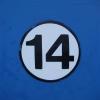I hope this might be of interest - I wasn't previously aware of Malcolm Campbell's military service - especially that of his time with the Royal Flying Corps and RAF. I took a quick look through his RFC record and in case it's of use, I've bullet-pointed his service as follows (apologies if it's a bit heavy with RFC terminology - happy to explain further if required):
As a newly-transferred Lieutenant in the RFC (attached from Ex- 2/5th Royal West Kent Regt) he marched in to No.1 School of Instruction at Reading on 18 September 1916.
To 27 Reserve Sqn, London Colney on 30 November 1916 (MFSH/MFLH) for elementary flight instruction.
To 28 Sqn at Gosport 14 December 1916.
He took his RAeC ticket (No.4301) on 27th February 1917, tested by Mr. Bucknall. His RAeC photo (I assume taken some time after its award) shows FE.2b 6969 “Malaya No. XVIII - The Singapore No.1“ in the background. This machine was donated on 23 May 1916 and served with 23 Sqn from/by October 1916 and was struck off on 11 May 1917. I’m assuming that the photo was taken at SARD (see below).
Attached to No.1 Aux School of Air Gunnery 27 February 1917.
Returned to 28 Sqn at Gosport 3 March 1917.
Marched in to Southern Aircraft Repair Depot, Farnborough 7 April 1917 as Ferry Pilot.
To Lympne Aeroplane Erection Park on 21 May 1917 as Ferry Pilot.
To Lympne Aircraft Acceptance Park 2 September 1917 as Assistant Officer i/c Despatch; the unit became No.8 AAP on 12 October.
He received a Medical Board on 22 October 1917, which seems to mark the end of his flying career: he was assessed as, “Unfit General Service 2 mths, Home Service 1 mth, fit Light Duties no flying”.
On 5 December 1917 Campbell was posted to No.5 School of Military Aeronautics at Denham, his RFC record appended, “view to apt as Asst Instr for 6 SMA”. 6 SMA was scheduled to form at Bristol early in 1918 but Campbell would remain at Denham as a ground instructor.
Subsequent Medical Boards reported of him:
14 December 1917: unfit GS 1 mth, fit HS 1 mth lim flying, dual at first.
3 January 1918: unfit GS 2 mths, fit HS 1 mth no flying.
25 January 1918: unfit GS 1 mth, fit HS 1 mth no flying.
25 February 1918: unfit GS 2 mths, fit HS 1 mth no flying PUPO [permanently unfit as pilot officer?]
Census 68 around this time reported, “Flying Officer knowledge of French & German. Built own machine in 1909. Experience in high speed petrol engines from amateur motor car racing. Since joining RFC [has flown] BE.2c, [BE.] 2e, FE.2b, [FE.]2d, AW, SE.5, DH.4, Henry [Farman], Martinsyde”.
He received a Medical Board at Hampstead on 1 May 1918: “Unfit GS, Fit HS ground duty only”; another MB of 31 July 1918 confirmed the previous findings.
On 3 September 1918 (effective 13 June) he was re-classified from Flying A & S to Tech B and promoted to temporary Captain while so employed. Another Medical Board of 5 September found him Fit HS Ground duties only.
On 4th February 1919 he reported to the Crystal Palace Dispersal Centre and was placed on the Unemployed List the following day.
London Gazette of 3 June 1919: awarded Military MBE.
I expect his army career is detailed somewhere - assume service with the BEF?















